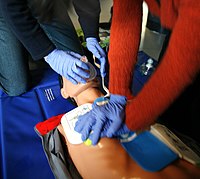
Photo from wikipedia
Background Chest compression is a standard recommendation during cardiopulmonary resuscitation (CPR). However, chest compression cannot be effectively applied under certain situations, such as chest wall deformity, rib fracture, or hemopneumothorax.… Click to show full abstract
Background Chest compression is a standard recommendation during cardiopulmonary resuscitation (CPR). However, chest compression cannot be effectively applied under certain situations, such as chest wall deformity, rib fracture, or hemopneumothorax. An alternative method, abdominal compression, was reported to achieve better resuscitation outcomes in these patients. Materials and methods A prospective study was performed in adult patients with cardiac arrest and anticipated ineffective chest compression (thoracic trauma, chest deformity, rib fracture, and hemopneumothorax). Active abdominal lifting and compression cardiopulmonary resuscitation was used. Primary outcome was success rate of restoration of spontaneous circulation (ROSC). Secondary outcomes included heart rate (HR), mean arterial pressure (MAP), pulse oximetry saturation (SpO2), arterial blood pH value, arterial oxygen pressure (PaO2), and arterial carbon dioxide tension (PaCO2), which were measured during the periods of pre‐CPR, CPR, and 30 min post‐ROSC. Results A total of 35 patients were enrolled into the study. Five of them had ROSC (14.3%), which was statistically significantly higher than that (0%) reported in the 2015 Advanced Cardiovascular Life Support manual. HR, MAP, and SpO2 during CPR were also statistically significantly higher during CPR when compared to the period of pre‐CPR period (HR 58 versus 0 beats/min, P < 0.01; MAP 25 versus 0 mm Hg, P < 0.01; SpO2 0.68 versus 0.48%, P < 0.01). In post‐ROSC period, HR was statistically significantly higher than that during pre‐CPR period (121 versus 0 best/min, P < 0.01). Conclusions Active abdominal lifting and compression cardiopulmonary resuscitation could reach better resuscitation outcomes in certain cardiac arrest patients.
Journal Title: American Journal of Emergency Medicine
Year Published: 2017
Link to full text (if available)
Share on Social Media: Sign Up to like & get
recommendations!